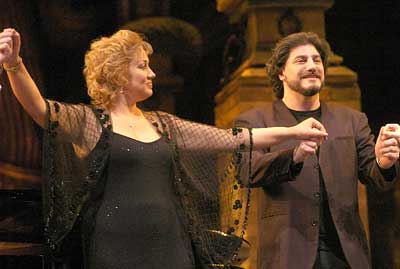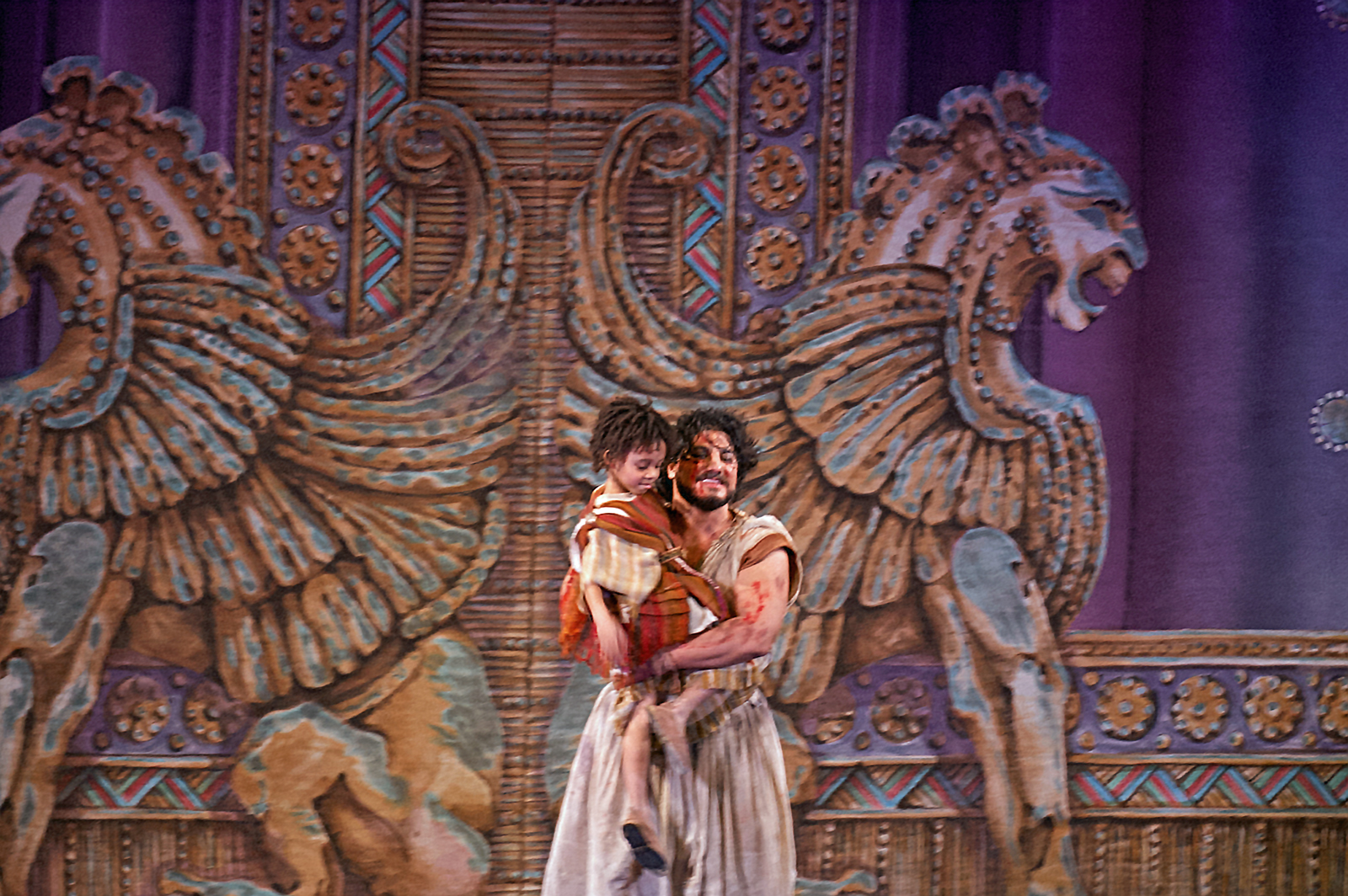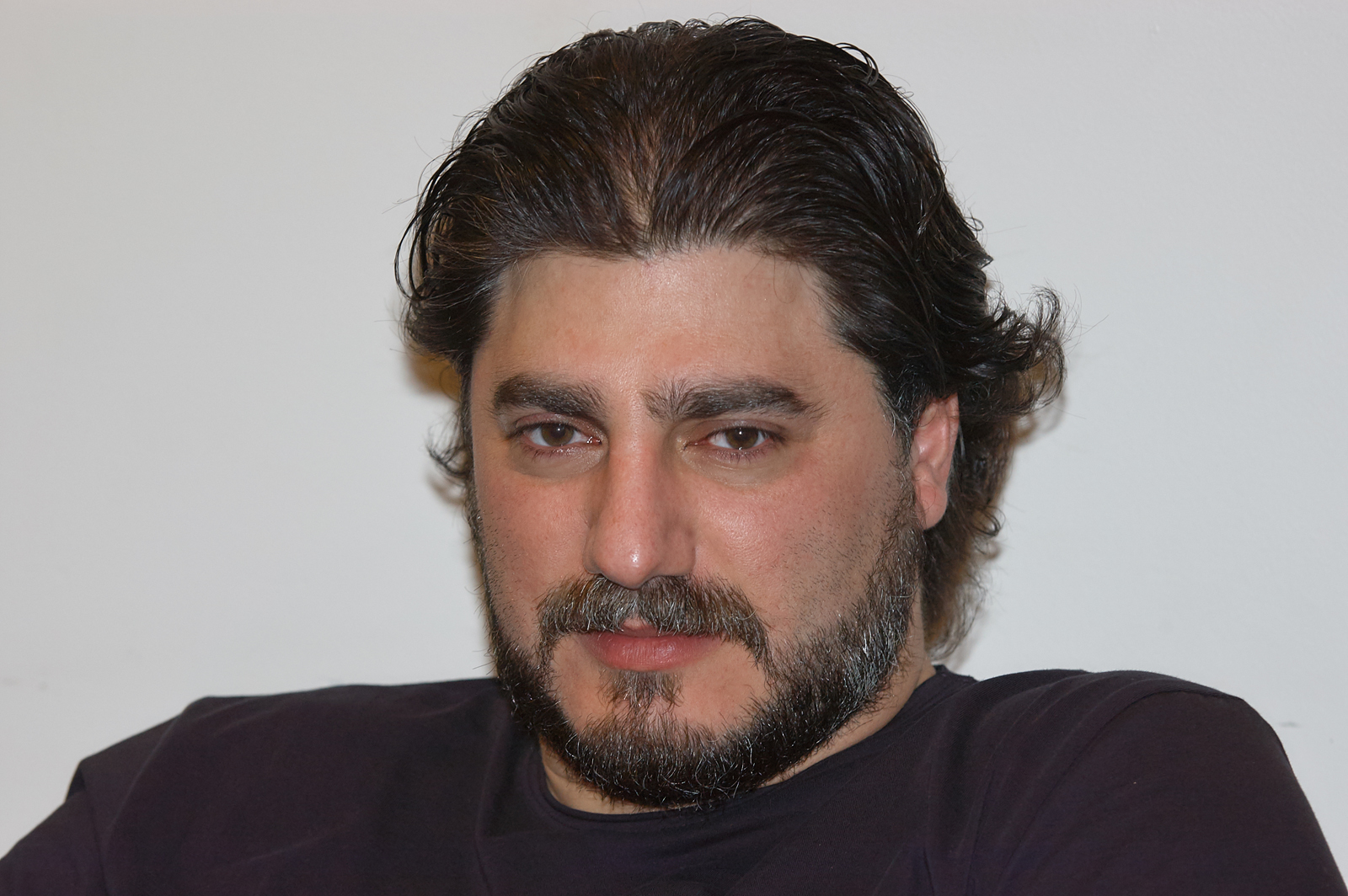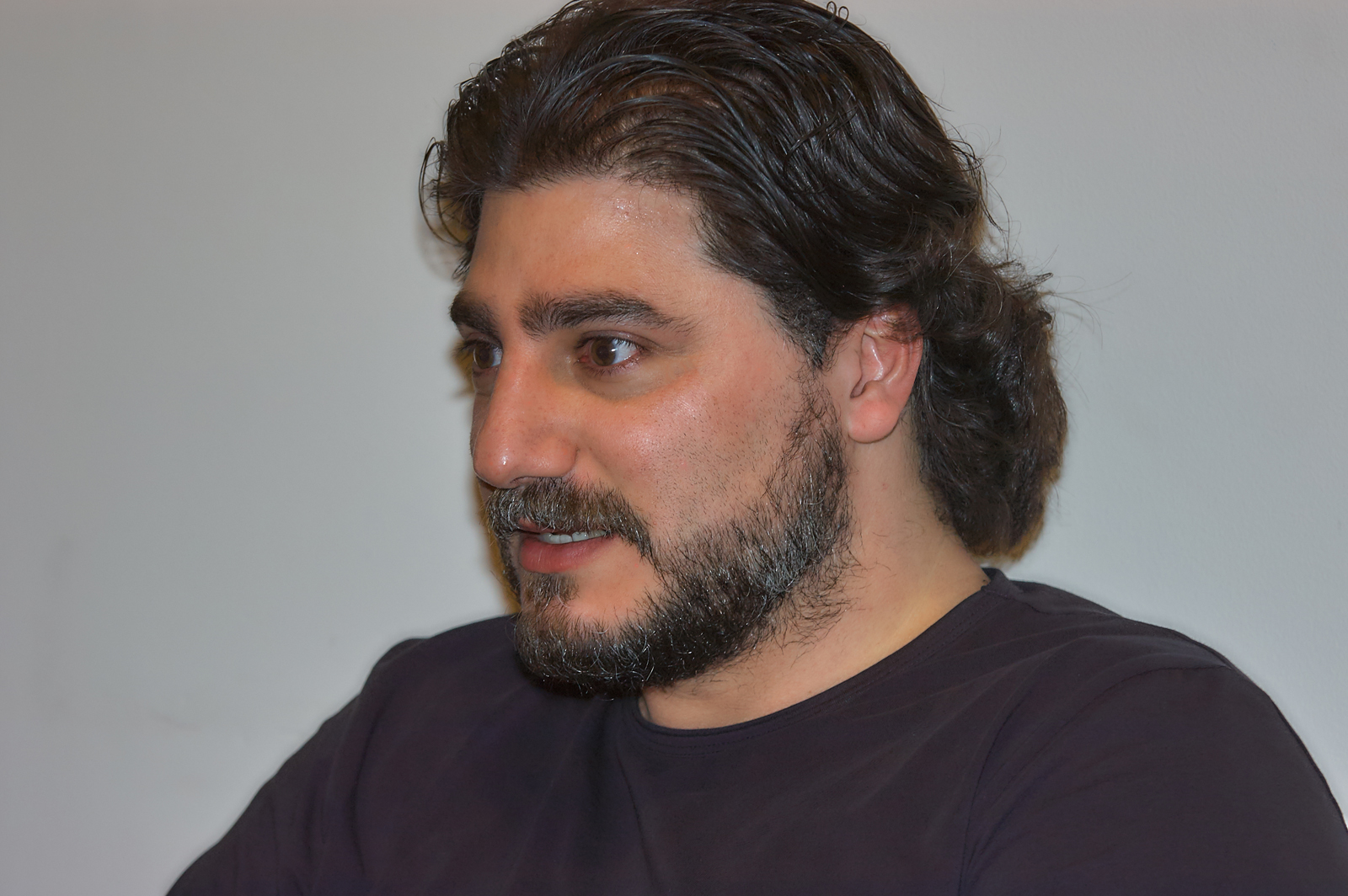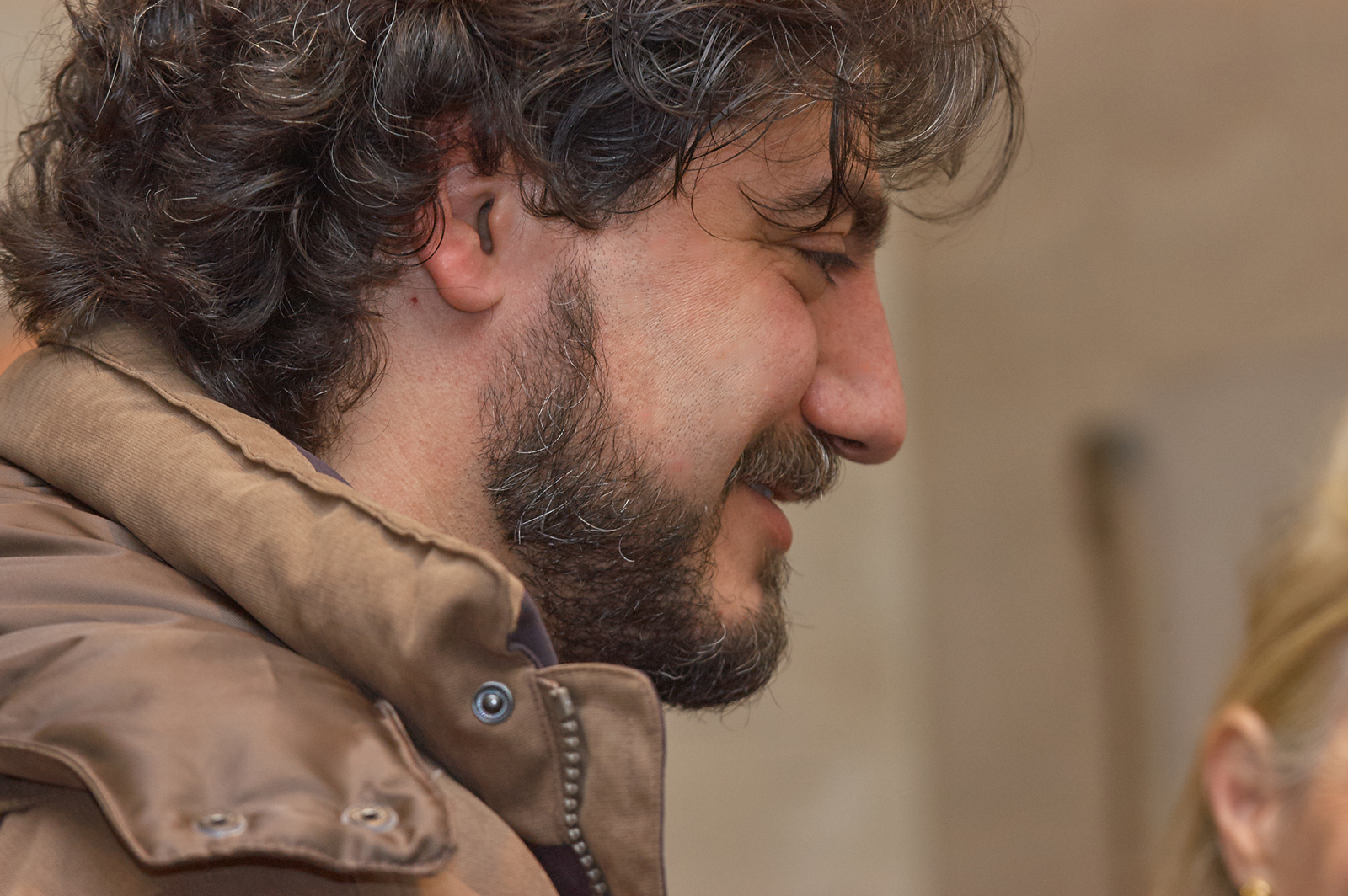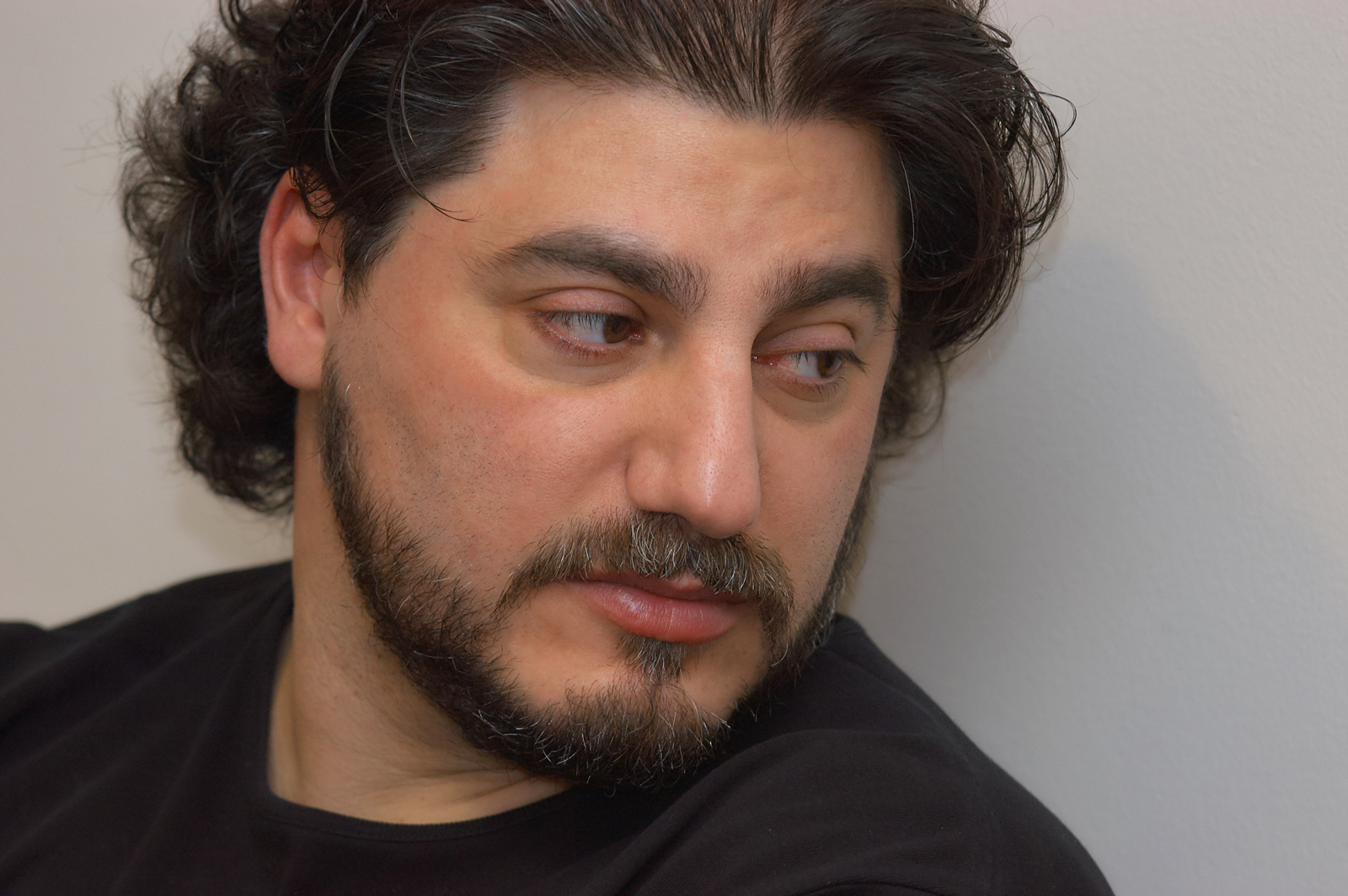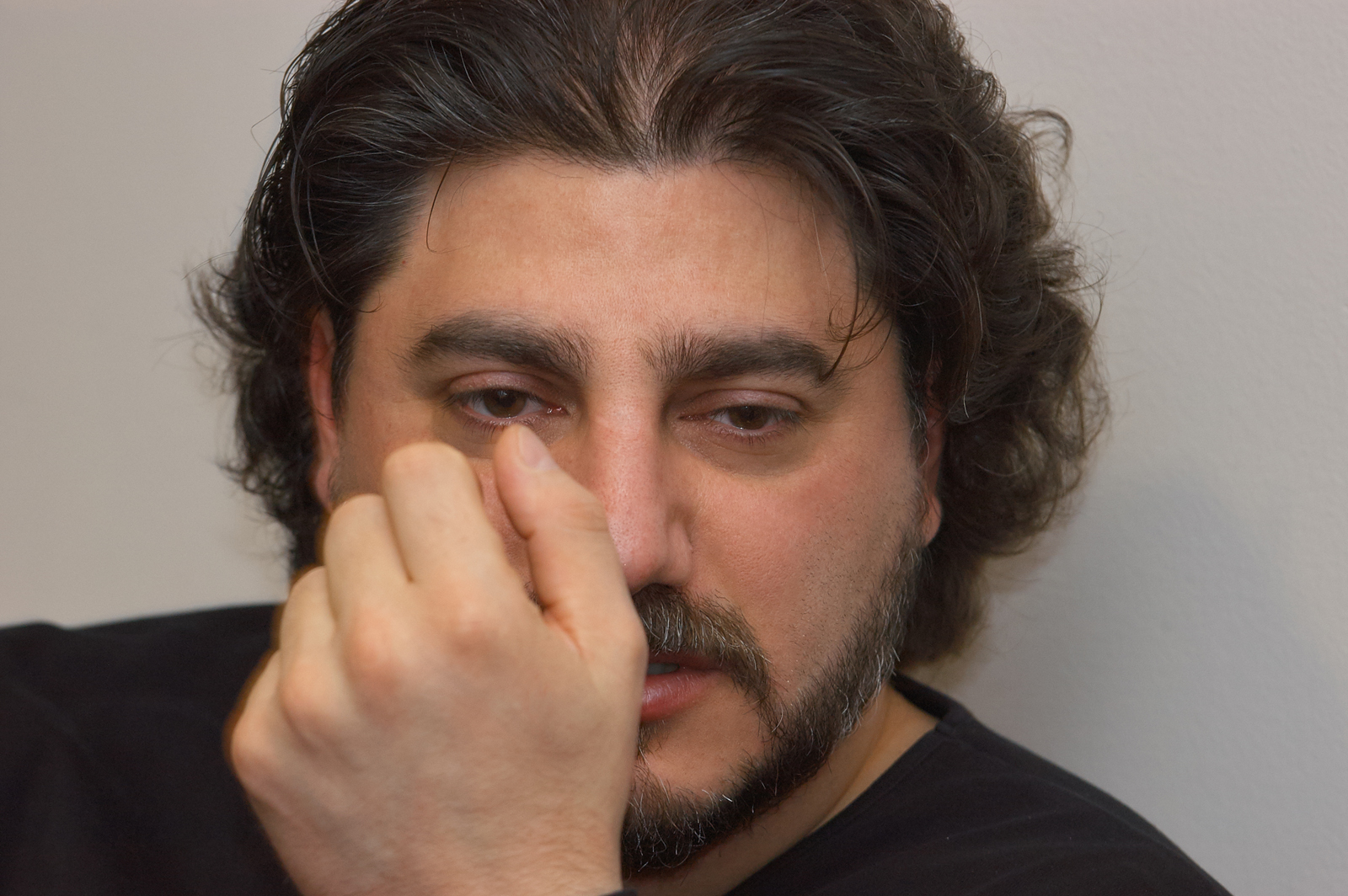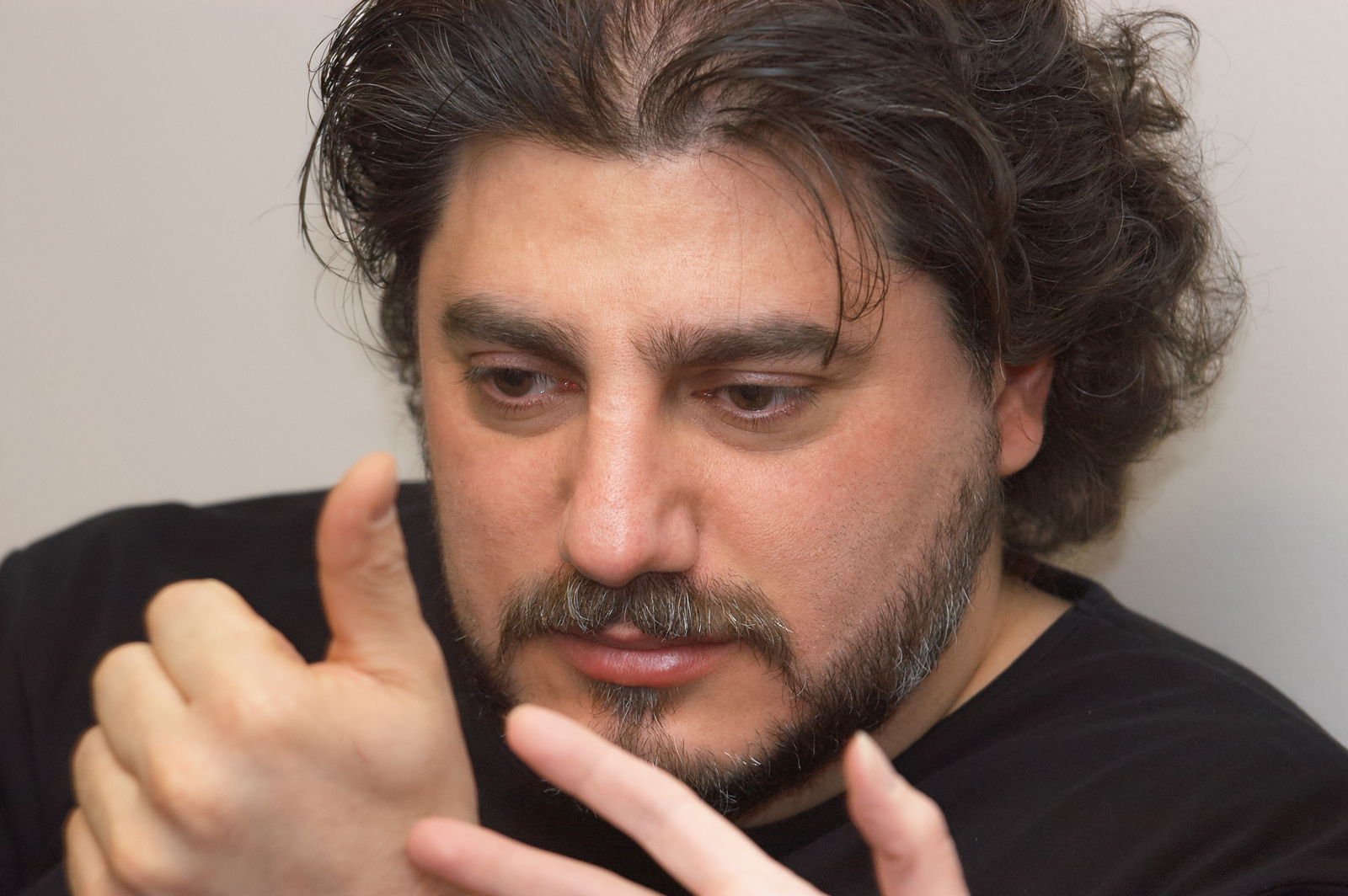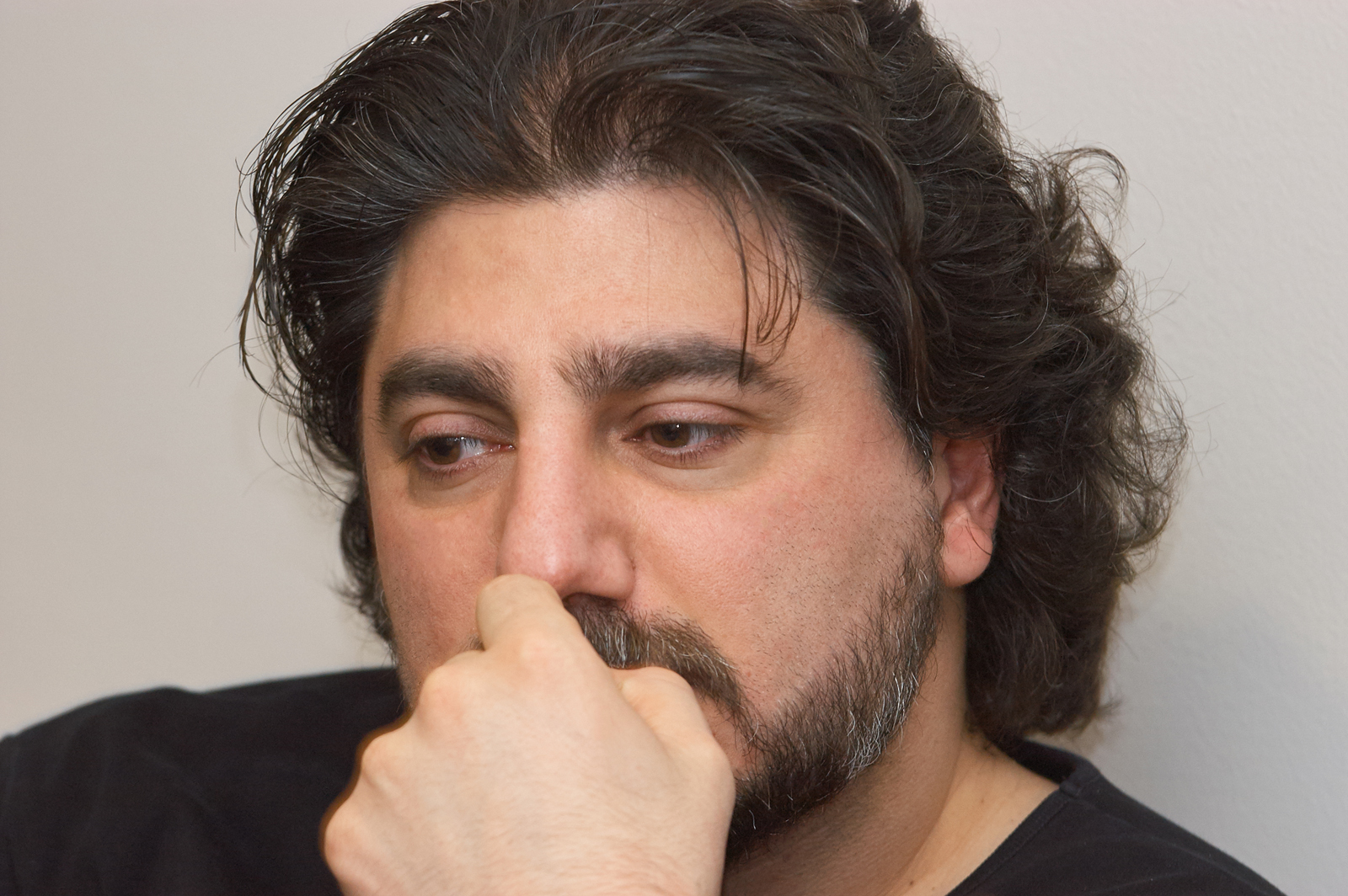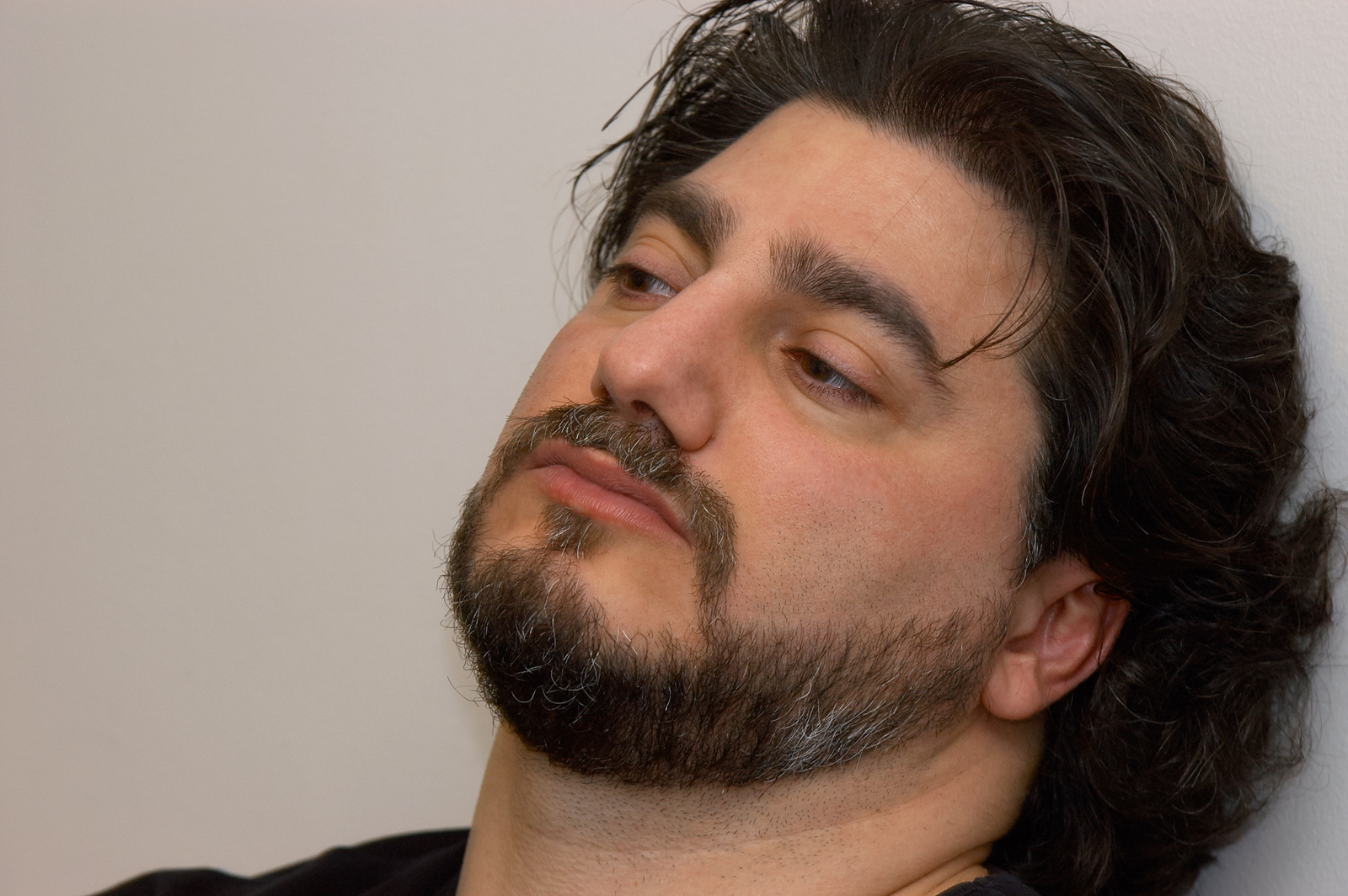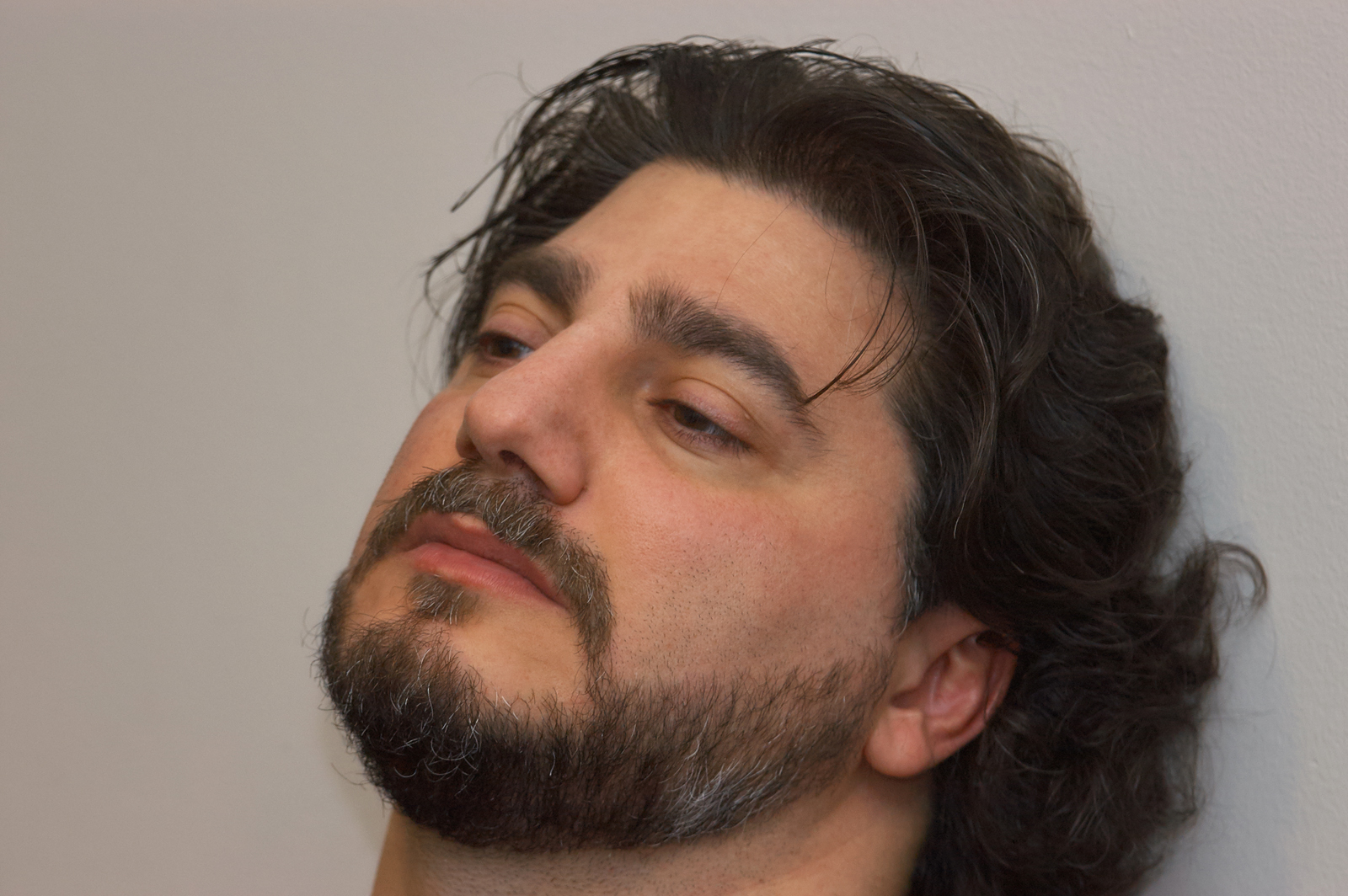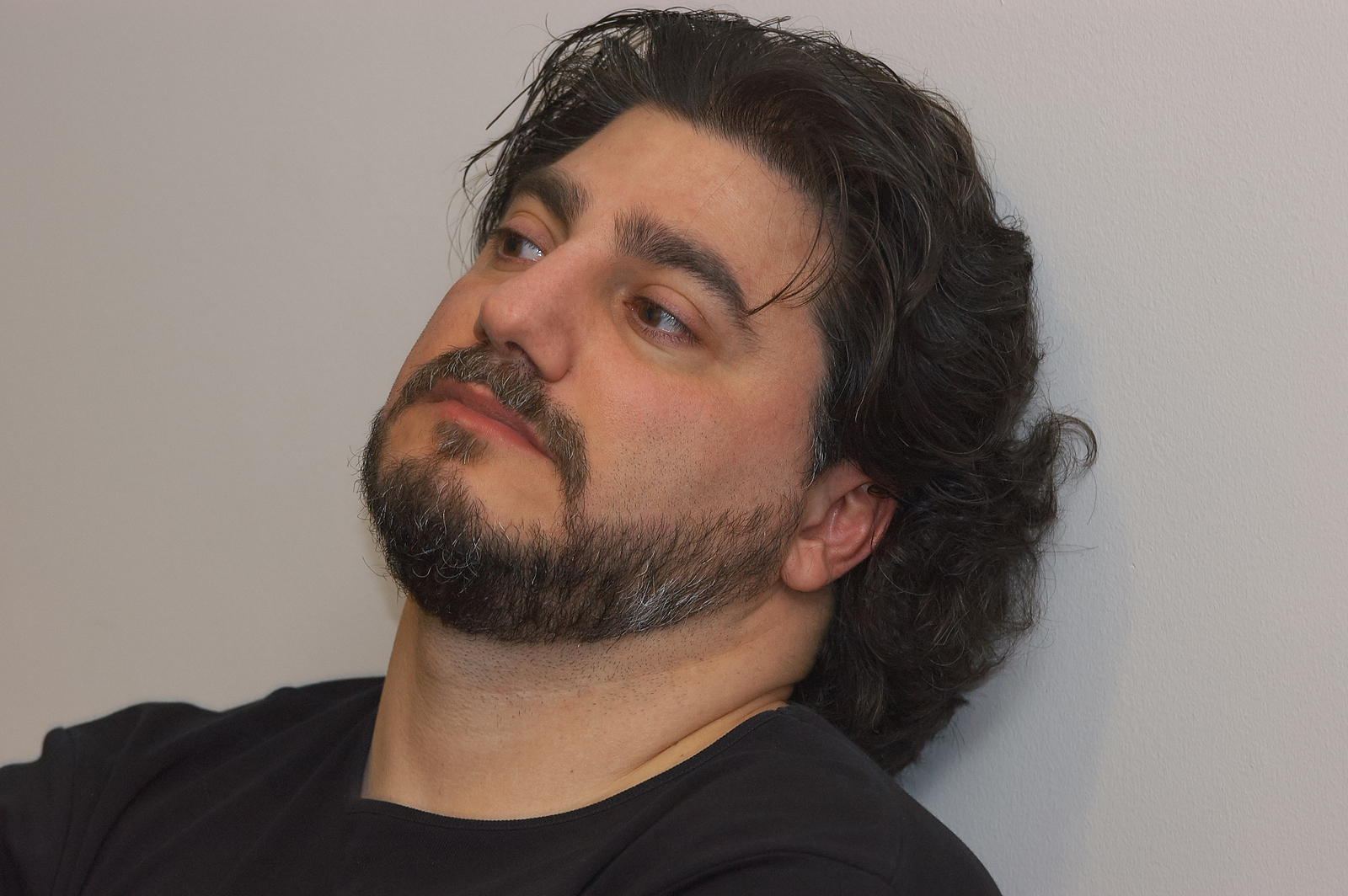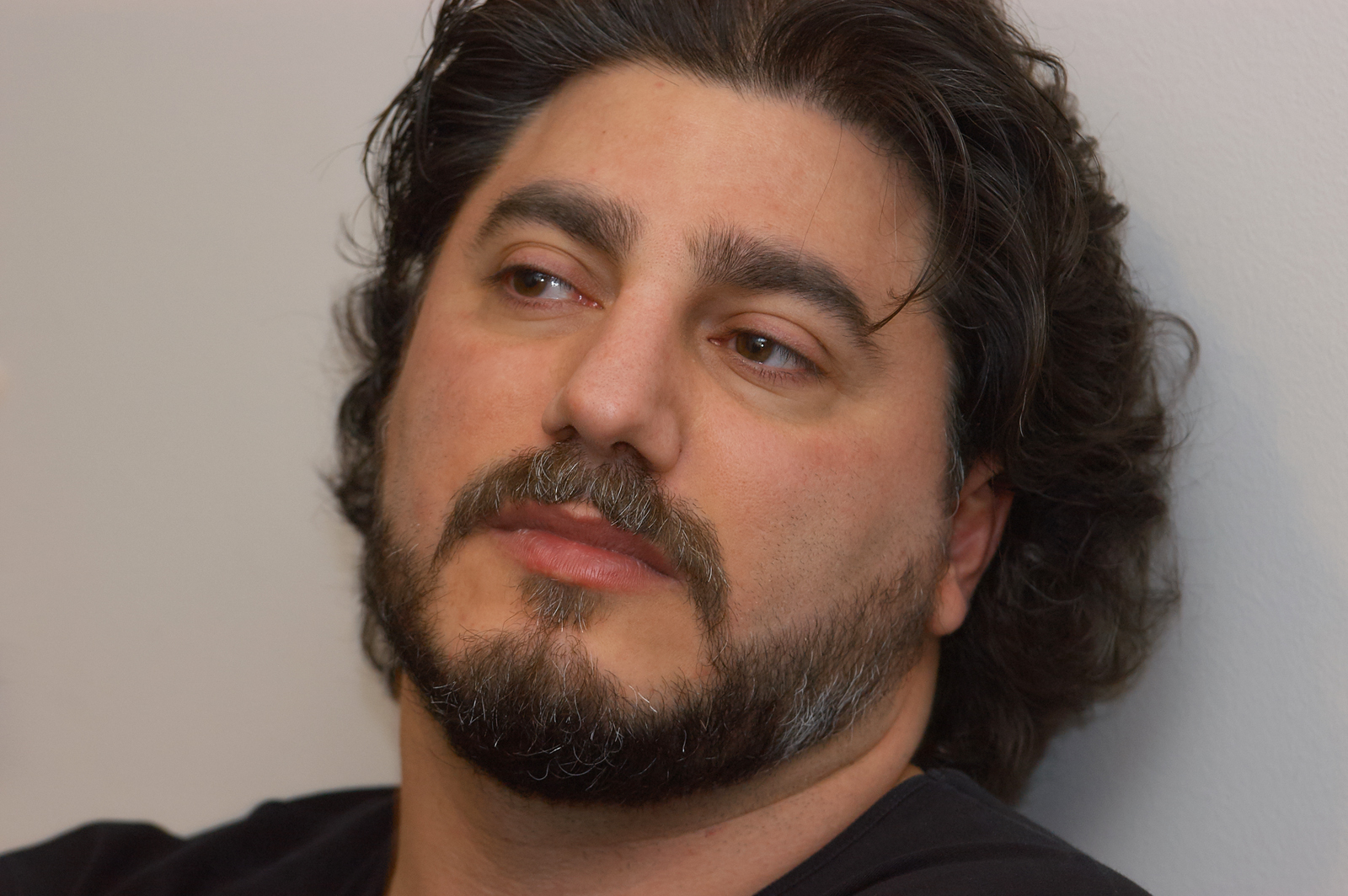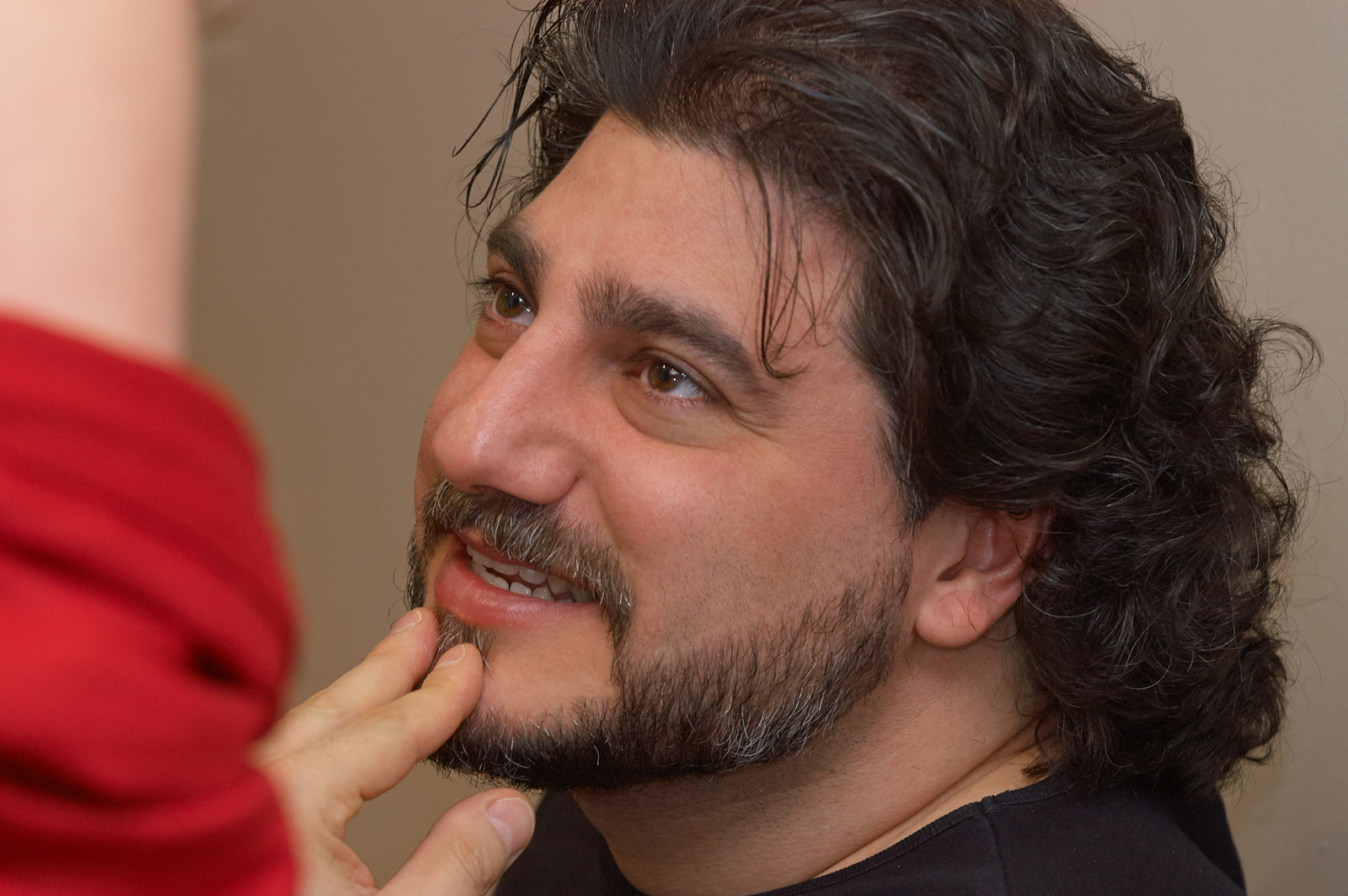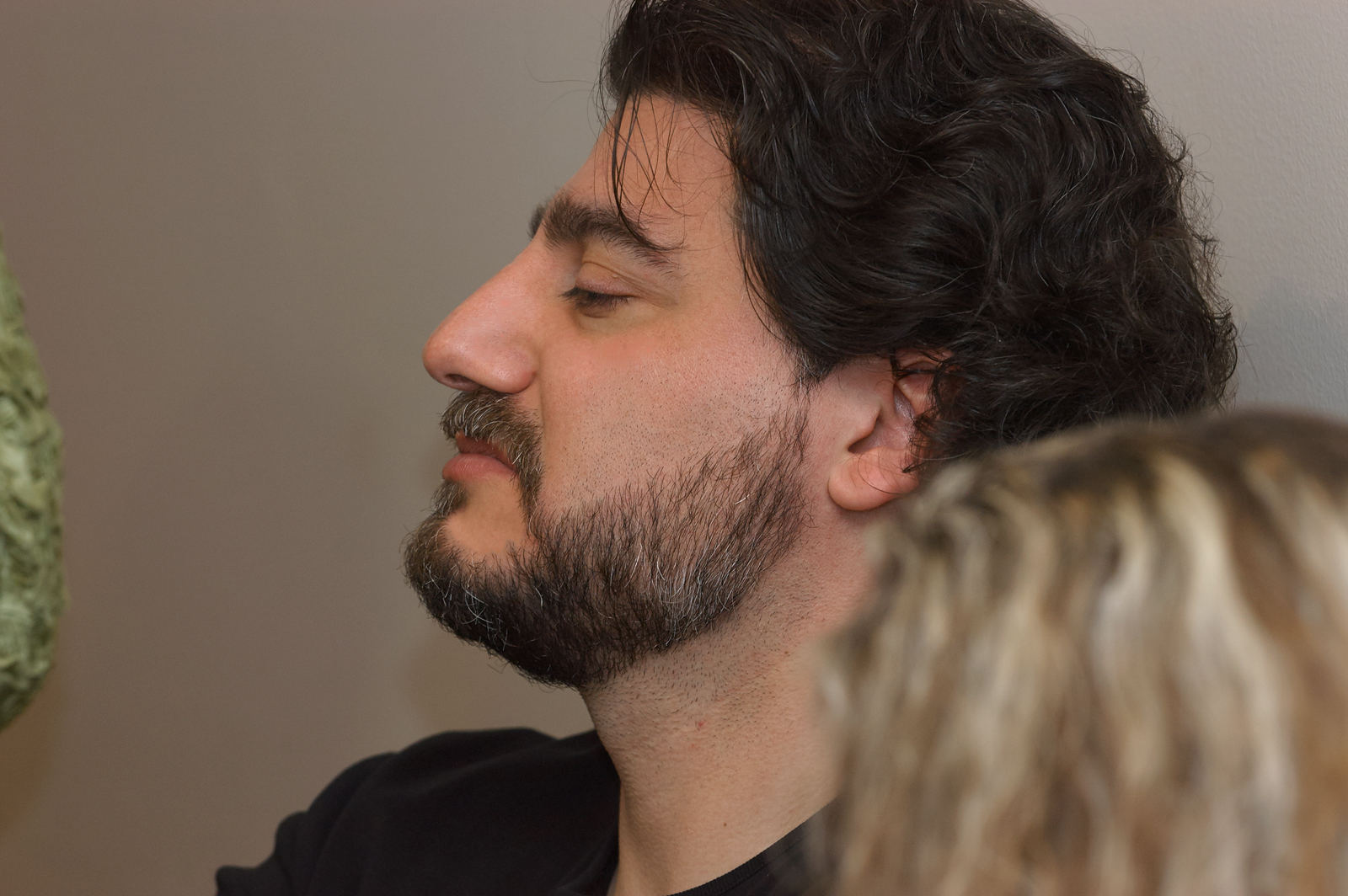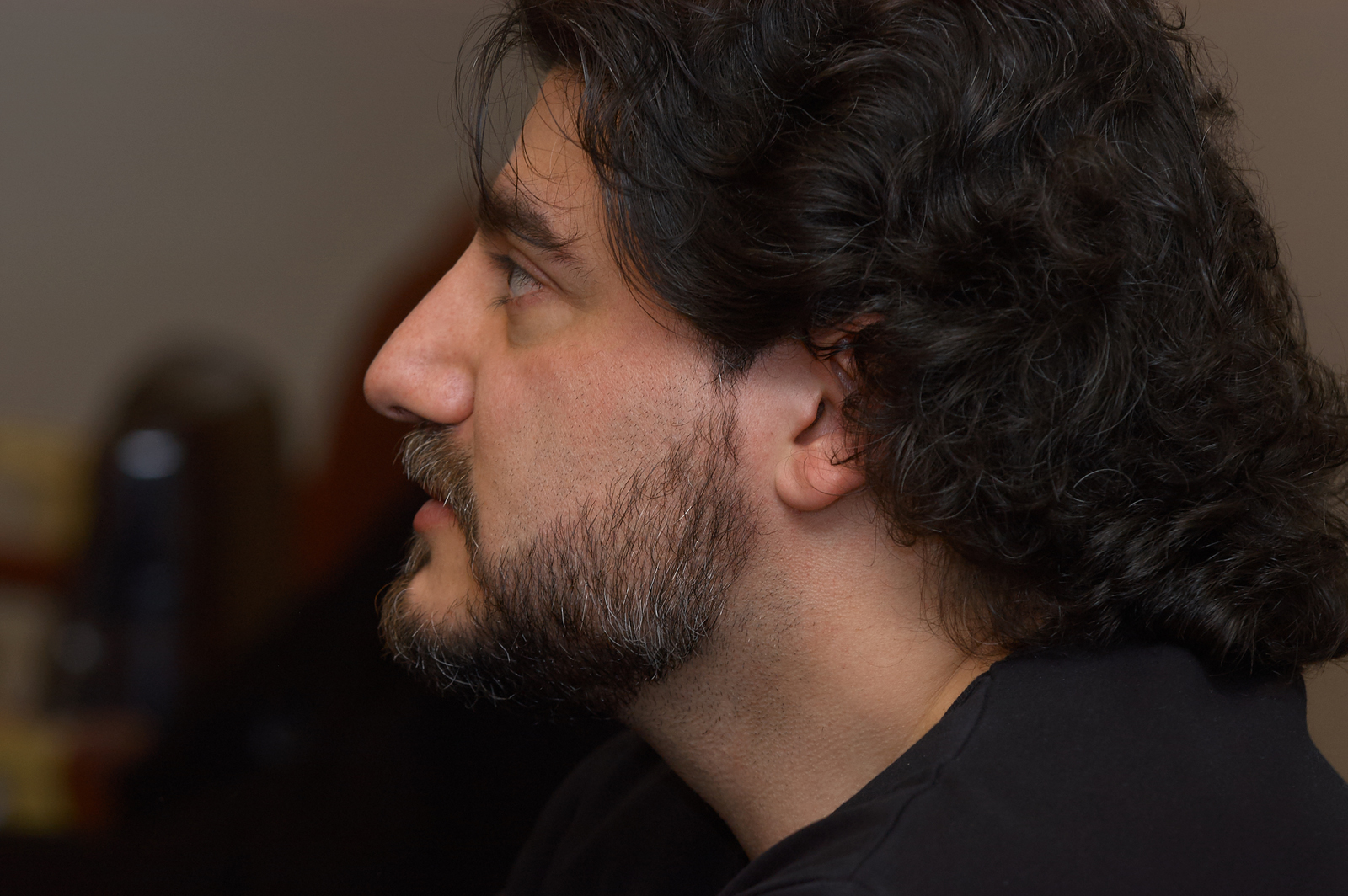|
In
Search of the Real Samson and Dalila
from Lyric Opera News
Winter 2003/2004
“Samson
et Dalila is certainly sexier than any opera written
before it,” declares Russian mezzo-soprano Olga Borodina,
the star of St. Petersburg’s Kirov Opera, who will sing
Dalila in her Lyric debut.
In
its initial stages however, Samson et Dalila was
neither sexy now an opera. It was 1867 when Camille
Saint-Saëns started working on his Samson
oratorio. After hearing it performed, Franz Liszt
suggested his colleague rethink it as an opera. There
was one problem, though: in France, prevailing attitudes
of the time prevented biblical scenes being portrayed on
the stage, even in liberal Paris. As a result,
Samson et Dalila (opera in three acts, libretto by
Ferdinand Lemaire), premiered on Dec. 2, 1877, in
Weimar, Germany. It was not staged in France until 13
years after its Weimar premiere.
For much of the 20th century, audiences
considered Samson et Dalila to be old-fashioned,
but that is no longer the case. “The audience nowadays
accepts conventions that were diff icult to accept during
the 20th century,” says conductor Emmanuel
Villaume, who will lead Lyric’s Samson in his
company debut. “Sometimes pure beauty of the vocal line
and clarity were equated with a lack of depth, but today
people are beyond this,” Indeed they are. Modern
audiences agree with those of the 19th
century: Samson et Dalila contains some of the
most beautiful music every written for the opera house,
including one of the most famous and most seductive
arias in all opera, “Mon Coeur s’ouvre a ta voix.” In
addition to gorgeous arias, the opera also offers a
temperature-raising, semi-orgiastic bacchanal scene
which shows that if nothing else, those Philistines knew
how to party! icult to accept during
the 20th century,” says conductor Emmanuel
Villaume, who will lead Lyric’s Samson in his
company debut. “Sometimes pure beauty of the vocal line
and clarity were equated with a lack of depth, but today
people are beyond this,” Indeed they are. Modern
audiences agree with those of the 19th
century: Samson et Dalila contains some of the
most beautiful music every written for the opera house,
including one of the most famous and most seductive
arias in all opera, “Mon Coeur s’ouvre a ta voix.” In
addition to gorgeous arias, the opera also offers a
temperature-raising, semi-orgiastic bacchanal scene
which shows that if nothing else, those Philistines knew
how to party!
In
keeping with its oratorio beginnings,
Saint-Saëns’s opera contains choruses which, as
Villaume points out, “are not exactly involved in the
development of the action, but rather a commentary on
the action.” While the confrontational scenes between
Samson and Dalila are quite dramatic, Villaume thinks
there is a different purpose for their presence: “They
are a way for the composer’s musicality to express
itself. Ultimately what Saint Saëns is going for is a
score of great musical power, color, and balance, but I
don’t think he is going for pure dramatic effect. He’s
always staying a musician. He’s using the power of the
story to express something and to portray something
which is first of all a musical idea.”
Even though the work started out as an oratorio, it
contains plenty of drama – especially in this
production, with José Cura playing Samson. “If I were
to portray Samson as a nice, sweet character, an Old
Testament prophet, I would not be portraying the real
Samson,” he says.
Do
not think that José Cura could ever be less than real:
“The Argentinian tenor gives to Samson all the strength
of his magnetic presence, all the energy of a vocal
emission of unseen arrogance,” wrote Sergio Segalini of
Opera International. “Cura confirms himself to
be the only possibly imaginable performer for Samson
since Jon Vickers’s retirement.”
Indeed, the “Samson of our times” has strong feelings
about the role. “Samson was not a prophet but a
warrior,” Cura says. “To put it in modern terminology,
Samson could be an Old-Testament terrorist, who believed
in killing anyone who didn’t think the way he did.”
At
least, that is how Cura sees Samson in the first two
acts. “In Act One he is an Old-Testament Che Guevara.
In the second act we see that Samson completely
misunderstands the spiritual meaning of his life. He
was of the flesh – a man filled with animalistic
adrenalin – and that is why he was so easily corrupted.”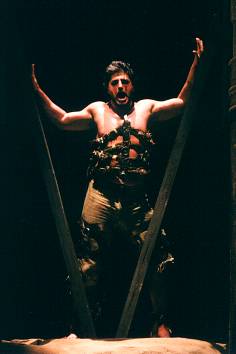
But was he corrupted, or did he simply surrender to
Dalila’s love? Borodina thinks Dalila is something more
than a biblical femme fatal. “My Dalila loves
Samson very much,” she says. “But Dalila is a patriot
and she remembers her duty.” The libretto shows this
dichotomy: “Love come to my aid . . . Fill his heart
with your poison,” Dalila sings. “A god much greater
than your speaks through me – my god, the god of love.”
(Borodina spoke to Lyric Opera News by phone
during a family vacation at her dacha in the
Russian countryside.)
Once Samson surrenders to Dalila he becomes powerless,
is blinded by his captors, and winds up doing slave
labor. He begs his people to forgive him and begs God
for the return of his strength. Not surprisingly, when
his strength is miraculously restored, Samson uses it to
kill the Philistines by pulling down the temple. (If
the story sounds like a Cecil B. DeMille
sword-and-scandal epic, it is! DeMille directed the
1949 movie Samson and Delilah starring Victor
Mature and Hedy Lamarr.)
Cura sees something more to the story than a strong man,
a sexy woman, and tumbling pillars. “Samson completely
misunderstood his gift of strength,” he says. “He
thought his strength was given to him so he could
destroy anyone who didn’t agree with him. He may have
thought he was very spiritual, but he was not. He
reduced everything to simply killing and taking. The
real Samson, and I mean ‘real’ in the sense of the
spiritual character, is seen early in the third act when
he begs his people for forgiveness for what he has
done. It is there that he finally sees his real
mission, which of course leaves us suspended in
conflicting thoughts. Samson becomes very spiritual in
asking God to give his back his strength, but when he
gets it, he pulls the temple down killing everyone.
Today solving problems through war and aggression is
something that is seen on every TV newscast. The story
of Samson is not that old-fashioned after all. In
Samson’s time strength was in muscles – today it is in
bombs.”
To
Cura, having a certain quality of voice is absolutely
essential for Samson. Despite that fact that the
character is a tough, primitive kind of guy, a good deal
of subtlety is needed to portray him, and while “might
makes right” in the biblical story, there is much more
than raw power needed for this role. “You can sing very
loud, but if you do not sing deep and dark and accent
the proper words, then the whole psychological impact of
Samson gets lost.” Cura says. “It is the same in
Otello. It is not about singing loud but singing
with just the right color. It is one thing to sing all
the notes with great volume, but if you don’t have the
proper color, then you lose that extra ingredient that
makes the character believable.”
|
While in Chicago....
Super-Tenor
Shines on Bloomington
22 January 2004
Eric Anderson
Indiana Daily Student
|
The events of José Cura's still-blossoming opera
career have already become the stuff of legend:
He learned the role of Ruggero for Puccini's 'La
Rondine' while performing in Verdi's 'La Forza del
Destino' by attending 'Rondine' staging rehearsals
in the basement of the opera house during the second
act of 'Forza,' when his character was not present
on stage.
In 1999, he made history at the Metropolitan Opera
as only the second tenor in the company's history to
debut on opening night (the first being the grandest
of all tenors, Enrico Caruso, in 1902).
Just a year ago, he further cemented himself into
music mythology by first conducting Muscagni's
one-act opera 'Cavelleria Rusticana' at the
Hamburgische Staatsoper, then mounting the stage
after intermission to perform the role of Canio in
'Pagliacci.'
The School of Music had the good fortune to catch
this growing titan of the opera world between
performances for a special guest lecture and
masterclass.
His lecture, "Singer, Musician…Antonyms?", attracted
a large and attentive crowd to Auer Concert Hall
Sunday night, where Cura spoke for nearly two hours
over the beginnings, triumphs and frustrations from
his extensive career as a professional musician.
Seated on the edge of the stage, dressed in a black
sweater and blue jeans, Cura gazed at the seats
directly in front of him.
"Do you know how I feel coming out here to speak,
only to find the first two rows empty," he asked in
his strong Argentinean accent. "I refuse to start
until you all move up and fill in the front rows.
"You," he called to those in the balcony, "come down
here, the ticket price is the same!"
Cura began the lecture with an interesting question.
"How does the world regard tenors?" he asked. "Like
a piece of shouting meat."
For the next hour and a half, Cura was part
autobiographer, part philosopher, his penchant for
storytelling never failing to deliver a comic
anecdote or pearl of professional wisdom.
"Study, work, bloody your fingers," Cura said.
"That's the best luck in the world."
Proclaimed by many to be "a true renaissance man,"
the tenor certainly does not fall easily into any
category.
Though he is now famous for his interpretations of
the great tenor roles -- among them Verdi's Otello
and Saint-Saëns' Samson, which he is currently
performing at the Chicago Lyric Opera -- Cura
actually began his musical studies with no
aspiration to professional singing.
His first piano teacher rejected him for having, in
Cura's own words, "no gift for music," and so he
decided instead to study the guitar.
Ernesto Bitetti, a professor of guitar at the School
of Music was instrumental in arranging Cura's visit
and has been a long-term friend of the Cura family.
He said he remembers young José in his pursuit of
guitar mastery.
"I've known him since he was 14 ... he was a very
talented guitarist," Bitetti said. "Now, of course,
he is better at his singing."
In fact, Cura was apparently so taken with the
instrument he wrote a letter to the IU School of
Music expressing interest in completing a guitar
major at the Bloomington campus. (He was,
unfortunately, rejected, as the school did not yet
have a guitar performance program.)
Cura was soon studying conducting and composition
and in 1991, at the insistence of a university
choirmaster, departed for Europe to pursue a
professional career in voice. The rest, as they say,
is history.
For all his worldly experience and artistic
expertise, Cura displays a remarkable ease with the
students around him.
Tenor Emilio Pons, who was the first to sing in
Monday morning's masterclass, was chastised by Cura
for spending "half the aria deciding whether you
were nervous or not."
Cura encouraged Pons to overcome his nerves by
drawing a parallel to performing Verdi's 'Aida.'
"When you open 'Aida,' [it's so difficult] you think
'f-k you, Verdi,'" he said, eliciting laughter from
the audience gathered in Sweeney lecture hall.
"People ask me what technique I use [to
prepare]…there is only one technique," Cura said.
"Balls."
"[Cura] is very comfortable," said tenor Eduardo
Gracia, who also sang for him that day. "He
transmits calm."
His easy, straightforward and always diligent manner
revealed itself again while Cura coached soprano
Carelle Flores in interpreting the text of her
Puccini aria.
"Have you ever been kissed?" he asked her directly.
"Was it a revelation of passion?
"Come on," he said, responding to her embarrassed
laughter, "haven't you ever made love? Of course
not…you are all nuns here."
It is hard to believe that this man, himself so full
of passion, still encounters more than his share of
resistance in the music industry.
Toward the end of the 1990s, tired of his played-up
image as the sex-symbol of opera, Cura declined to
renew his contracts with both his agent and
recording label. Now, there are opera houses that
find it too politically unsavory to engage him. His
CDs are harder to find. And yet, he has found a
greater peace as a free agent opera star.
"Now," he said, "I look in the mirror every morning
and I am happy. I only go to sing where people want
me to sing ... they're not there because they were
invited.
"Plus," he added, "I have contracts until 2010, so I
can't complain."
And his audience certainly had no complaints either.
"Spectacular" was the word of choice for Marianne
Kielian-Gilbert, a theory professor.
"You never see this [kind of event]," she said.
"This is right where it should be happening."
Cura concluded Monday's class by performing his
final scene from Verdi's 'Otello' -- a scene that
has garnered him both praise and criticism for his
exceptionally theatrical interpretation.
Cura has brought an extensive amount of research and
analysis to the role, not to mention a deep dramatic
commitment -- and all were evident to the audience
as he played out the suicide of Otello with such
abandon as to suggest he had mistaken Sweeney Hall
for the Teatro alla Scala.
Having heaved Otello's final breath, Cura looked up
from the floor where he knelt, breathless from his
exertion, and whispered: "If I continue singing for
20 years, it will be like this."
His audience, myself included, certainly hopes so.
|
|
José Cura offers master class worth cheering about
25 January 2004
Peter Jacobi
Herald Times
|
World-class tenor José Cura made a Sunday-Monday
stop in Bloomington this past week and proved that,
despite opinions some in the realm of music cling
to, a tenor is not "a piece of shouting meat" and
that Maria Callas was generalizing when she referred
to that category of singers as "beasts."
Quite
the contrary, the seemingly genial, relaxed Cura,
dressed for both a lecture and master class in jeans
and loose-hanging collarless top, made quite an
impression as a generous and sagacious gentleman,
both ready to and capable of giving very good
advice.
He was
here thanks to Ernesto Bitetti, the head of guitar
studies in the IU School of Music, and the Lyric
Opera of Chicago. To explain: Bitetti has been a
long-time family friend, one who, when the tenor was
a boy in his native
Argentina
encouraged him to take up music. The Lyric Opera is
Cura's current artistic home; he's appearing there
in Samson et Dalila as the hero with the long hair
who falls for the wiles of the scheming woman who
shares the opera's title.
Bitetti
suggested that as long as he was in the area, why
not drop down to
Bloomington
and give
the voice students some sage counsel. Cura agreed,
his interest fed also by the fact that more than 20
years ago, when he yearned to become a guitarist, he
wrote to the music school seeking admission, only to
be told that no degree in guitar performance was
available, only a few courses. Cura turned to other
avenues and other places.
On
Sunday evening in Auer Hall, he spoke about those
other avenues and places. The guitar, though he
loved it deeply and still does, was not to be his
musical specialty. He discovered that he simply
wasn't good enough. Instead, he turned to choral
conducting and to composition and, finally, to
singing. "There were disappointments along the way,"
he said. "When I was seven, my father sent me to a
piano teacher. 'No gift,' the teacher told him. I
decided on rugby and built my muscles. A friend told
me to play the guitar to be more successful with the
girls."
And so
went visitor Cura's account, through twisting roads
of study and shifting career goals (although
determination to make music his life never
faltered), through marriage and children and
financial crises. "I didn't want to be a singer,
really. Now conducting, ah! But the best advice came
from a teacher who said, 'You have to study singing.
It's the only way you'll become a conductor.' And so
I did. And look what happened. But if someone comes
to me to offer a job as conductor, I'll quit
singing."
Cura's
audience was bulging with voice students. "What's in
your heart?" he urged them to ask themselves. "How
do you see yourself in 10 years? This business is a
jungle. You have to have a goal." He admitted to
luck being a factor to have his level of success.
"The train passes once, maybe twice, and you must be
ready to catch it or be left in the desert. But it's
mostly study and work."
Cura's
lecture was extemporaneous, definitely low-keyed.
His Monday master class in Sweeney Hall was charged
with electricity and was, for the three young
singers who performed for him and for those who came
to listen and learn, a concentrated lesson on
matters of interpretation, vocal control and
performance practice. Here he proved the master.
For two
hours, he listened and he taught. He advised. He
demonstrated. He amazed.
The
hours were rich with words worth remembering:
· "You
cannot be a musician in less than 10 years. And
then, 10 years more. Twenty years. Think of that.
Who is willing to do that today? Nowadays, we push
buttons to get quick solutions. You ask, why a
dearth of voices? That's why."
·
"You've broken the ice," he told the morning's first
singer. "That's one of the hardest things to do.
With your voice and courage, you'll go far. ... Now,
sing the aria again. You spent half of it trying to
decide whether to be nervous or not."
· "Put
your hands in your pocket. Act with your voice.
Overuse your hands, and when the time comes for
hands, no impact is left. Simplify your action."
· "Work
in front of a mirror. Don't let your face show the
tremendous struggle inside. That makes the viewer
uncomfortable."
·
"Don't ever let a pianist or conductor push you.
Take time to breathe, then move ahead. And don't
leave a note until you get from that note the best
sound possible."
· "I
can see you're nervous. You'll hurt your voice if
you try the next note," he told a soprano,
attempting for the minutes that followed to calm her
down. She did.
· "Sing
for you. A natural on stage never acts for the
audience. You portray a character. Show that you're
a mature woman falling for a younger man. Sing to my
eyes."
·
"You're very angry," Cura reminded a tenor after
completing a recitative to a Verdi aria. "Convince
me of that without overacting."
·
"Create the feel of something happening, that what
you're singing is immediate, not planned."
·
"Verdi was the genius. We are not. Our job is to be
expressive of what he wrote."
To prove
that last point, Cura devoted the final 30 minutes
of his session to explaining, then singing the death
scene from Verdi's Otello. He spoke of learning how
to die on stage without being ridiculous.
"Sometimes," he said, "you die for a whole act.
There's an edge between what's interesting and
believable and what is ridiculous. A thin edge." He
said he consulted a doctor, "If I stabbed myself,
would I die immediately? Would I bleed? Would I
suffer? If you stab yourself in the stomach, it
takes ages to die. When you remove your knife, you
really die. You see, it's up to us to find out how
Violetta or Mimi dies, how Riccardo dies for 20
minutes in A Masked Ball. The baritone has to stab
him the right way. And Otello does. He's a man of
weapons, and he knows."
Cura
discussed motivations that resulted in Otello's easy
fall to Iago's duplicity, the self-loathing, he
said, of a Muslim who has led Christian forces to
defeat his own people, a mercenary who feels
undeserving of Desdemona. "My Otello is not heroic,"
Cura explained. "He is a betrayer and hypocritical.
He sees that in those around him. Under that
psychological pressure, even a handkerchief can have
power. Alone, by himself, Otello is too cowardly to
destroy himself. He waits for someone else to do it
for him. At the end, he decides to be a Muslim
again. He can kill his wife. Because he loves her,
he suffocates her with a kiss and hands. He then
realizes what he has done and kills himself as a
supreme act of cowardice," choosing not to face
death from others who might want to punish him.
Using a prone woman student as the dead Desdemona,
Cura proceeded to act out and sing that death scene
with such passion and persuasiveness that this
listener came to tears and the audience gave him an
extended and cheer-filled ovation.
José
Cura had left advice and a strong impression.
Outstanding tenor, yes, but outstanding musician,
too. He had titled his lecture, "Singer and
Musician, Antonyms?" In his case, synonyms.
|
|
|


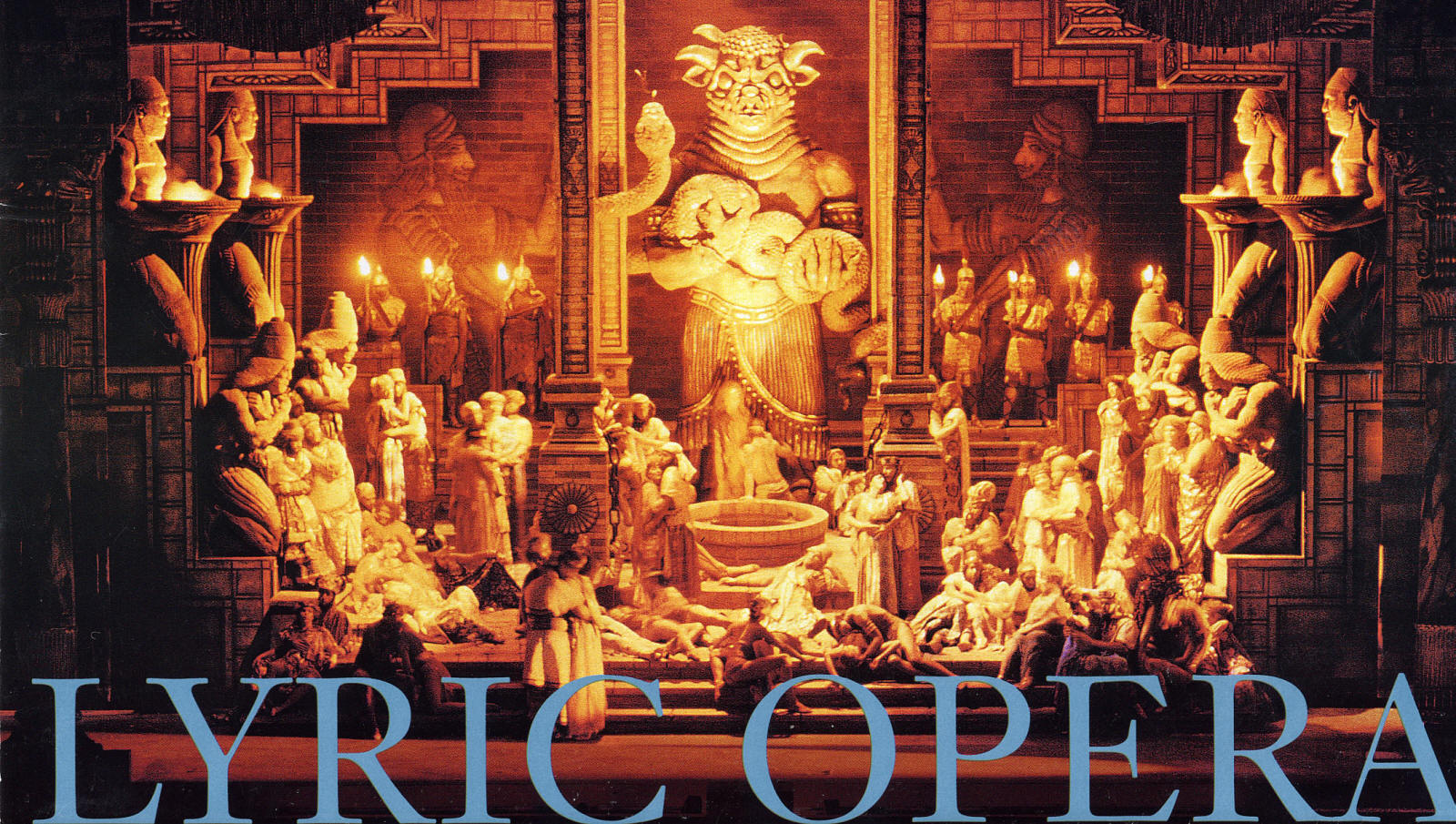
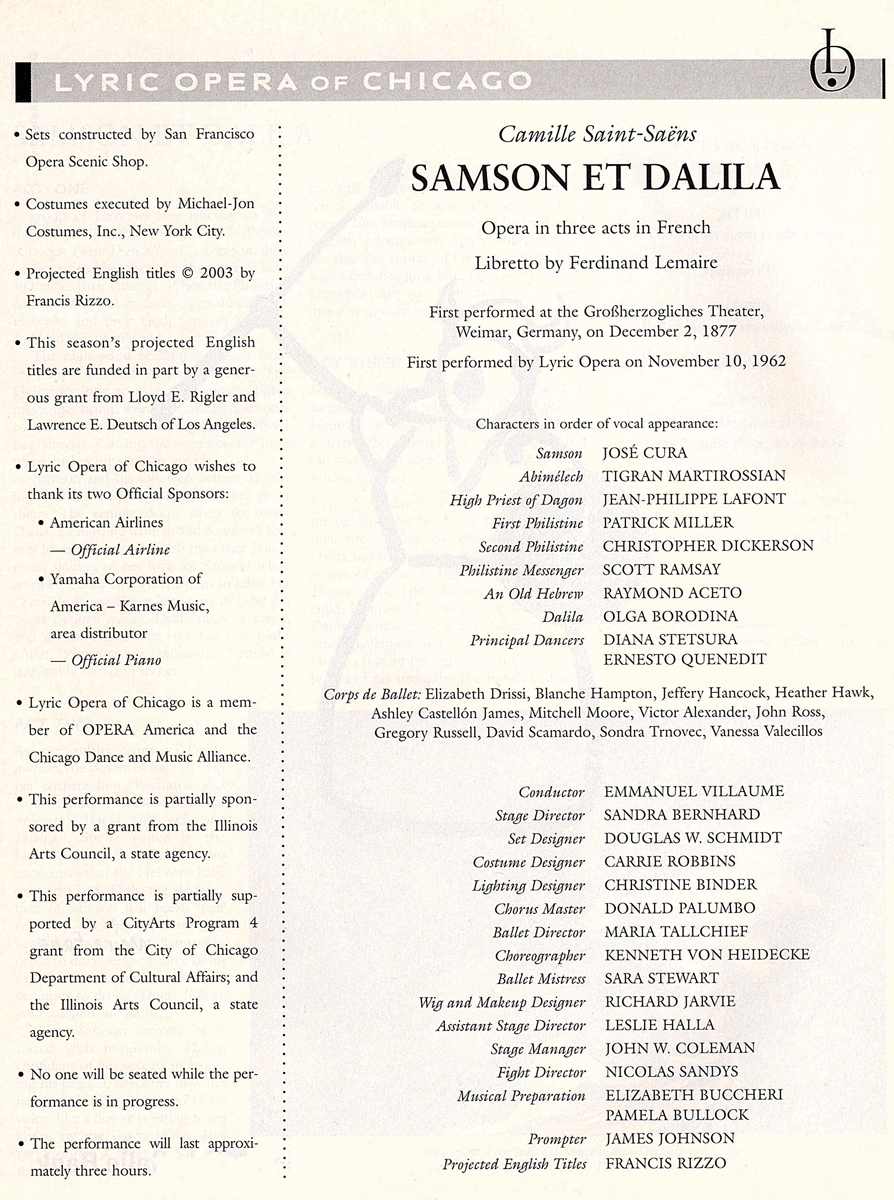
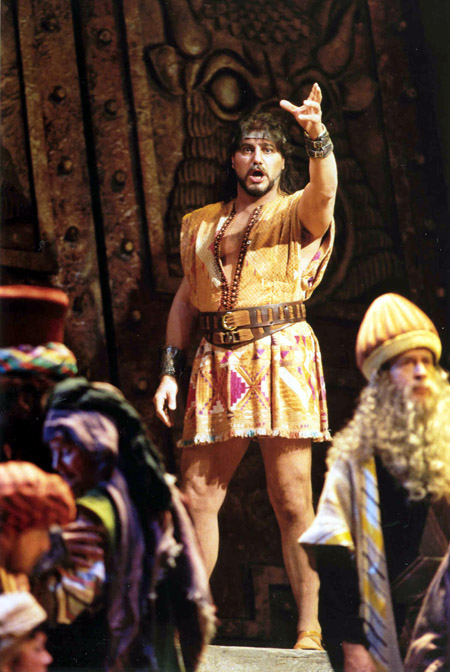
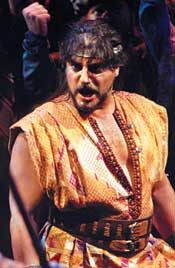
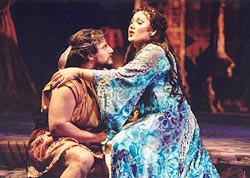
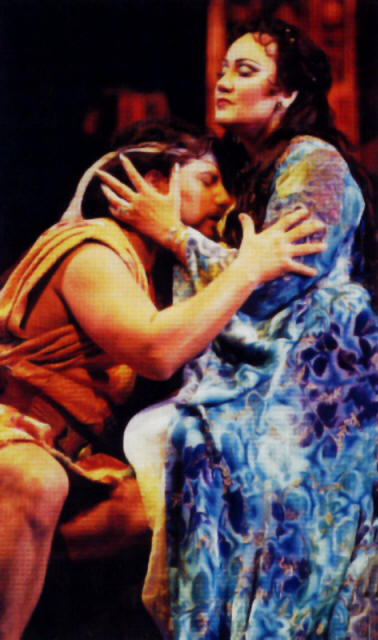
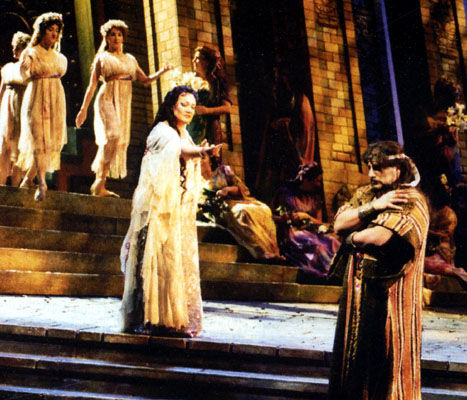
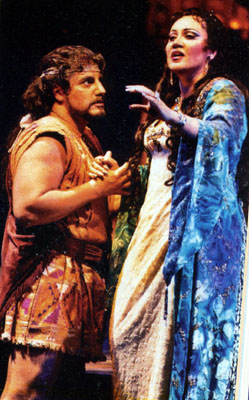
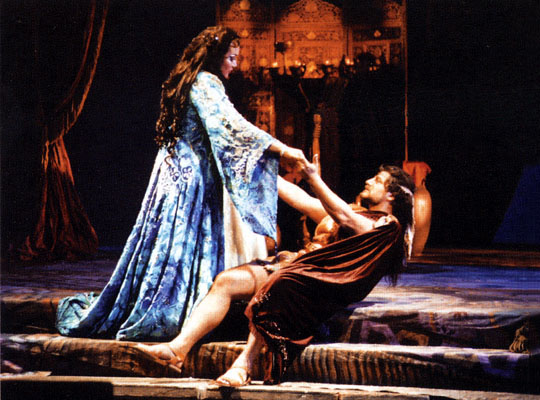

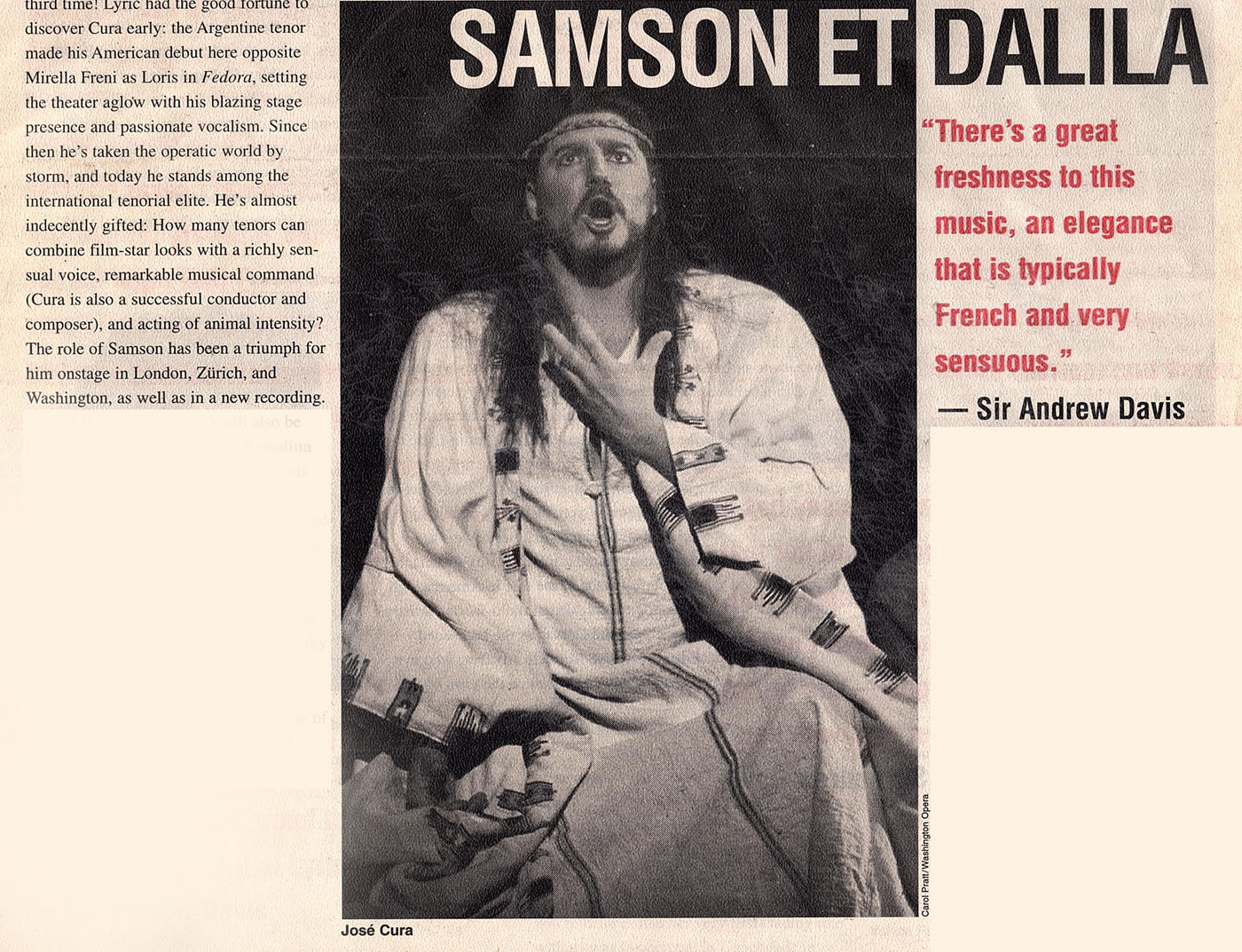
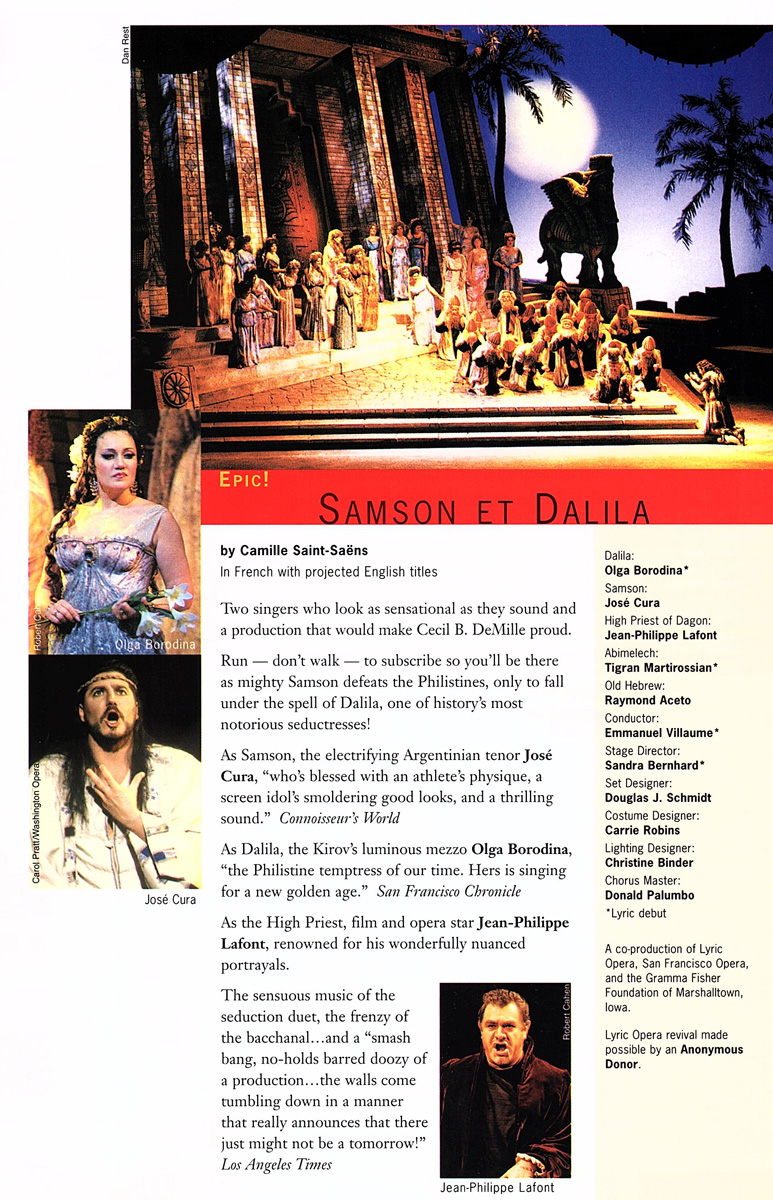
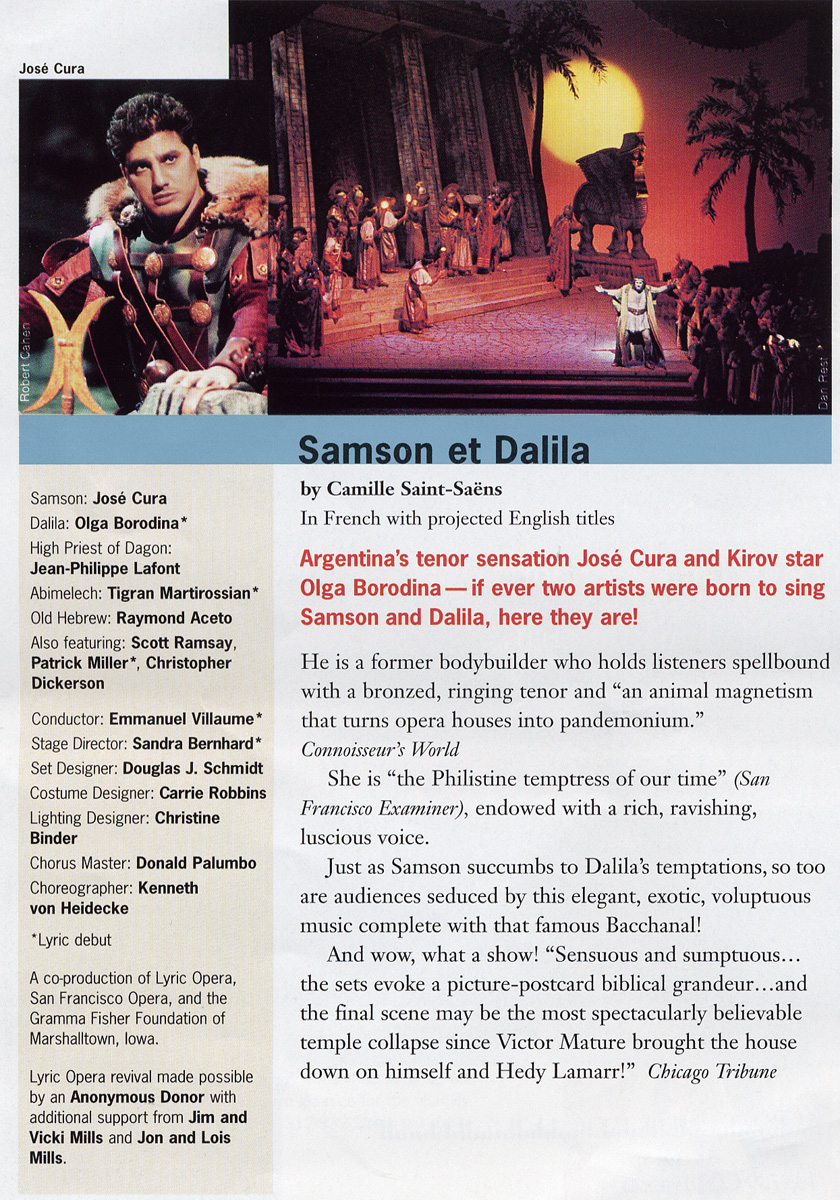
 icult to accept during
the 20th century,” says conductor Emmanuel
Villaume, who will lead Lyric’s Samson in his
company debut. “Sometimes pure beauty of the vocal line
and clarity were equated with a lack of depth, but today
people are beyond this,” Indeed they are. Modern
audiences agree with those of the 19th
century: Samson et Dalila contains some of the
most beautiful music every written for the opera house,
including one of the most famous and most seductive
arias in all opera, “Mon Coeur s’ouvre a ta voix.” In
addition to gorgeous arias, the opera also offers a
temperature-raising, semi-orgiastic bacchanal scene
which shows that if nothing else, those Philistines knew
how to party!
icult to accept during
the 20th century,” says conductor Emmanuel
Villaume, who will lead Lyric’s Samson in his
company debut. “Sometimes pure beauty of the vocal line
and clarity were equated with a lack of depth, but today
people are beyond this,” Indeed they are. Modern
audiences agree with those of the 19th
century: Samson et Dalila contains some of the
most beautiful music every written for the opera house,
including one of the most famous and most seductive
arias in all opera, “Mon Coeur s’ouvre a ta voix.” In
addition to gorgeous arias, the opera also offers a
temperature-raising, semi-orgiastic bacchanal scene
which shows that if nothing else, those Philistines knew
how to party! 
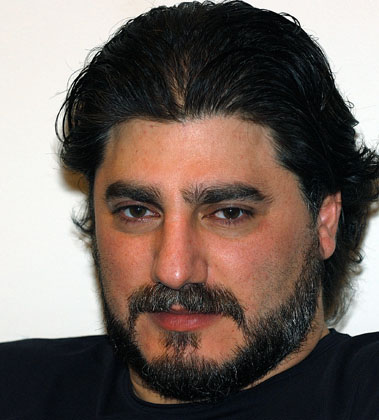
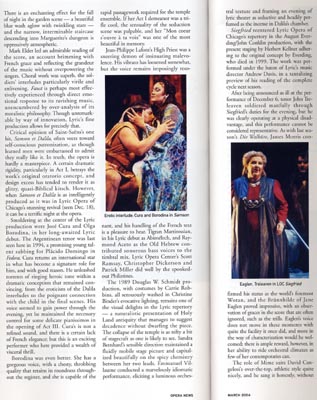 Critical
opinion of Saint-Saens’s one
hit, Samson et Dalila,
often veer toward
self-conscious
patronization, as though
learned men were embarrassed
to admit they really like
it. In truth, the opera is
hardly a masterpiece. A
certain dramatic rigidity,
particularly in Act 1,
betrays the work’s original
oratorio concept, and design
excess has tended to render
it as glitzy, quasi-Biblical
kitsch. However, when
Samson et Dalila is as
intelligently produced as it
was in Lyric Opera of
Chicago’s stunning revival
(seen Dec. 18), it can be a
terrific night at the opera.
Critical
opinion of Saint-Saens’s one
hit, Samson et Dalila,
often veer toward
self-conscious
patronization, as though
learned men were embarrassed
to admit they really like
it. In truth, the opera is
hardly a masterpiece. A
certain dramatic rigidity,
particularly in Act 1,
betrays the work’s original
oratorio concept, and design
excess has tended to render
it as glitzy, quasi-Biblical
kitsch. However, when
Samson et Dalila is as
intelligently produced as it
was in Lyric Opera of
Chicago’s stunning revival
(seen Dec. 18), it can be a
terrific night at the opera.